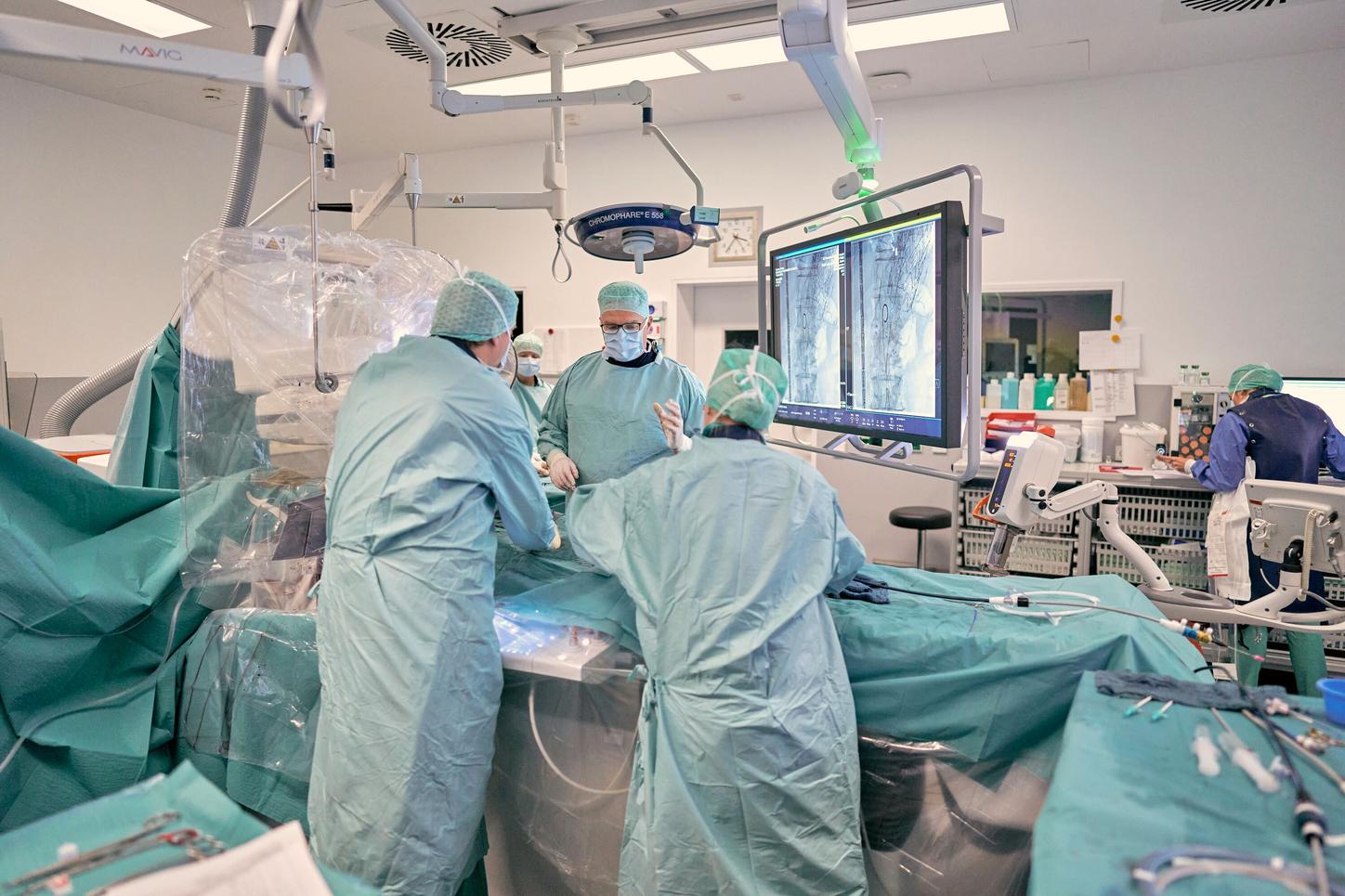Home
Perspectives
- Minimally invasive first

Minimally invasive first
Vascular surgeons in Münster focus on innovation and in-house research. This has a positive impact on complex procedures as well as on patients and staff.
The St. Franziskus Hospital in Münster, Germany, plays a very important role in regional patient care while also enjoying an international reputation for innovation. Martin Austermann, MD, is developing minimally invasive methods to treat patients more gently, safely, and effectively.
Procedures like this
require repeated angiograms, in other words X-ray images of the vessels, to be
taken intraoperatively to monitor every step. This would lead to a high level
of applied X-ray dose. But the team and its patients now benefit from the
latest generation angiography equipment. As Austermann reports, the experience
gathered with the device since it went into service in August 2020 is
persuasive.

Traditionally innovative
Another pioneering moment was in 2003, when the St. Franziskus Hospital commissioned Germany’s first hybrid operating room (OR) – the first to enable high quality intraoperative imaging. This took the hospital closer to its aim of minimizing open surgery and as often as possible treating patients on a minimally invasive basis. Immediate visualization of the blood flow also helps avoid costly and stressful revision surgery.

The surgical team discusses further treatment steps during the endovascular aortic repair procedure

Minimally invasive treatment of a thoracoabdominal aortic aneurysm requires high concentration

X-ray images show the surgeon if the operation was successful
Cooperation as basis for development
Cooperation with Siemens Healthineers was also key to efforts to build a second hybrid operating room at the St. Franziskus Hospital, and continues with another premiere: the installation of the latest angiography system, the ARTIS icono. The approach of treating complex disorders of the entire aorta, the neck vessels, and also strokes and critical ischemia of the legs as non-invasively as possible is being taken consistently further by the new chief Austermann and his team. They aspire to be involved early on in the development of advances in medical technology. This was also the case for the new angiography system.
Already at the prototype stage the vascular surgeons worked with the technology experts to pave the way for the integration of fusion imaging. The software automatically detects and marks vessel walls and branching vessels in the CT image created prior to surgery. It’s now possible to merge the CT image, the marked anatomical structures, and the current intraoperative angiograms; in other words they can be overlaid, or as Austermann puts it, “married.” The doctors can keep a permanent eye on whether the catheter or stent is in the right position.
Efficient workflows
Another improvement in workflow has been possible thanks to so-called Case Flows. This allows situations occurring during a procedure to be defined in advance so that the angiography system can take up the appropriate positions as standard during surgery. The vascular surgeons have already defined a number of different Case Flows and expect this to facilitate their work considerably.
Registration of CT data to angio system
Research for clinical application
To gather as much evidence as possible as the basis for developing patient care, the vascular surgeons are looking into many different methods in their own studies. To this end the Institute of Vascular Research has been established at the St. Franziskus Hospital. It covers a broad spectrum, with 24 studies currently under way. One example is bridging stents. They are approved for the treatment of arterial occlusive diseases, but also help when it comes to connecting branched stents to kidney vessels. Now the institute is investigating a proprietary method to see whether bridging stents can withstand the specific stresses around the kidney arteries in the long term.
Martin Austermann, MD and Michel Bosiers, MD work closely together during the procedure.

Another key area of research is imaging with carbon dioxide, particularly important for patients with high blood pressure and diabetes. Since the kidney function of these people is impaired, conventional contrast agents can increase the risk of potential unwanted side-effects. Now a registry study under Austermann’s leadership will take a thorough look at the safety of CO2 imaging.
The Department of Vascular Surgery looks after around 3,000 patients a year. To further improve their treatment, the doctors screen conference presentations and publications for the tools of the future. But the vascular specialists in Münster also want to share their insights with established and up-and-coming colleagues, and with nursing staff. They now have Vascupedia, a platform that provides structured information and dialog options for registered users from all over the world.
What is Vascupedia?
Share this page
1 AXIOM Artis FM
2 Results were presented at LINC 2021 (January 28th, 2021)
The statements by Siemens Healthineers customers described herein are based on results that were achieved in the customer’s unique setting. Since there is no “typical” hospital and many variables exist (e.g., hospital size, case mix, level of IT adoption) there can be no guarantee that other customers will achieve the same results.











